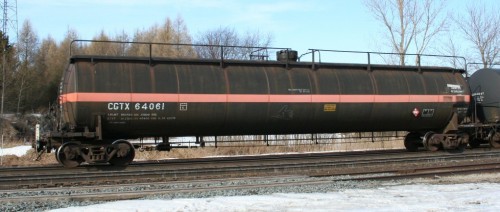Earlier this week I received a package in the mail with a collection of new-old stock Atlas tank car models from the very early 2000s that I managed to scare up on eBay. Among other things, included were a few of these ACFX chlorine service tank cars with the orange band that I’ve been looking for for a while, as it’s really something that places a setting as “post-1980 Canadian railway”.
The car is in a generic ACF lease scheme but that orange band tells a story – a specifically Canadian and ‘eighties one. During the 1980s, there was a short-lived Canadian government regulation requiring pressurized tank cars suitable for carrying hazardous compressed gases (both flammable and toxic inhalation hazards) to be painted with a bright orange horizontal band around the middle of the car as a very visible marker to first responder crews in the event of an incident. Non-pressurized cars did not receive these markings.
Although I can’t find a particular written source at hand, the common telling is that this regulation was one of the measures instituted in the aftermath of the infamous 1979 Mississauga wreck. Several factors however led to the eventual dropping of this requirement after a few years: a lack of universal adoption (as this was not a requirement in the United States, and it takes a number of years to apply the new lettering standards to an entire fleet of existing cars) and the eventual realization that when the paint burned off in a fire the visual cue wasn’t all that useful…
So the orange stripe was dropped, but even today if you’re lucky you can still come across older tank cars built or repainted in the 1980s that haven’t been repainted since and still show the stripe, although 30 years of repaints and retirements have seriously thinned their ranks.
I photographed the CGTX car above in a CN train at Copetown, Ontario in March of 2007 and the Procor car below was photographed just outside Sarnia in October 2014. Even 10-15 years ago in the early 2000s you could see the orange stripes a fair bit more often still on CGTX, CITX/DCTX and PROX cars and while fewer and farther between now, there are still survivors out there today that make for a splash of interest in a passing train.




So that’s what those orange stripes are for! Thanks for clearing that up… I learned something today.
I am 95% sure that the information in this post is entirely accurate. While the stripes are probably most well known (and occasionally still visible on) LPG cars, they appeared on many other smaller compressed gas tanks in chlorine, sulphur dioxide, vinyl chloride, etc. across all Canadian lease companies (PLM, PROCOR and CGTX), but the stripes did not appear on standard liquids cars.
Actually one thing I’m not sure of is if the stripes ever appeared on something like Carbon Dioxide tank cars, which is also shipped as compressed gas but without the same flammability or inhalation hazards.
Thanks Chris! Fascinating. I have a mint in box HO scale Atlas ACFX black/orange number 77325 (like the one pictured) that I do not need as it is the wrong era for the current stuff that I model. I was planning on bringing it with me to Woodstock on Sunday if anyone would like to buy it from me there? I am sharing a table with my friend Luc. Are you going to be there?
I did pass through Woodstock, but not until well after 2 pm, making it hardly worthwhile to stop in at the show, although meeting up would have been cool. Perhaps next time.
Did that car sell, or is it still available?
Yes it is. Pls contact me on my blog at https://qgryinhoscale.wordpress.com if you are interested.
Please refer to my article on Orange Bands in the January 2003 issue of Railroad Model Craftsman
Thanks Keith, I don’t have that one in my archive, if I see a copy I’ll have to check it out.
Thanks to Keith MacCauley for providing additional reference to the 1979 regulation:
Per C.T.C. (Canadian Transport Commission, now known as Transport Canada) Regulation 79.100-21(h) all pressure type tank cars were required to equipped with a full length 12” wide orange band located approximately center of the car. Rule 79.100-21(h) specifically stated:
‘Both sides and both ends of each pressure tank car that transports Class 2 gases after July 1, 1990 must have a one foot wide orange band approximately centered on a horizontal plane that passes through the centerline of the tank heads. The band must completely encircle the tank car except that lettering other than the orange colour may appear in the band. Safety appliances and handbrake part parts need not be of the orange colour.’
Class 2 is regulatory grouping of compressed gases, i.e. commodities that are only liquid under pressure. Chlorine, liquefied petroleum gases (LPG) and anhydrous ammonia are examples of Class 2 commodities. All eligible Canadian service tank cars regardless of ownership were required to be addressed. US Department of Transport (DOT) regulators did not adopt a similar requirement and furthermore expected un-banded US cars to be allowed to operate in Canada under a mechanism known as ‘reciprocity’ (reciprocity is a regulatory mechanism whereby each country agrees to abide by certain selected rules of the other – thus a US un-banded car could operate in Canada or a Canadian banded car would be acceptable in the US). Given the regulatory confusion, lack of US support and widespread shipper resistance the Canadian requirement was ultimately dropped, but not until after several hundred cars had been ‘banded’. Part of the overall opposition to the orange band was that if a fire was part of the calamity the visual indicator could be lost.